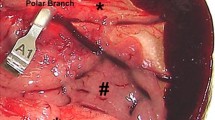Abstract
To establish a new experimental model of chronic pancreatitis (CP) with diabetes, we investigated pancreatic endocrine function, blood flow, and histopathology in CP induced by repetition of cerulein injection plus water immersion stress in rats. CP rats were treated with water immersion stress for 5 hr and two intraperitoneal injections of 20μg/kg body weight of cerulein once a week for 16 weeks. In the CP group, pancreatic contents of protein, amylase, elastase, and lipase significantly decreased to 64, 38, 23, and 68% of the control group, respectively. In oral glucose tolerance test (glucose 2 g/kg body wt), blood glucose level in the CP group was 212.1±97.8 mg/dl (mean±sd) at 30 min and was significantly higher than the control group (126.3±15.4 mg/dl) (P<0.05). Two of seven rats in the CP group showed an obvious diabetic pattern with a blood glucose level over 200 mg/dl at 120 min. The basal level of serum insulin in the CP group was 640.1±148.7 pM, significantly lower than in the control group (1133.4±242.0 pM) (P<0.001). However, insulin content in the pancreas was 12.37±1.72 nmol/pancreas and was preserved compared with the control group (10.24±1.94 nmol/pancreas). In CP rats, winding and dilatation of surface blood vessels and gland atrophy were evident. Marked fibrosis, fatty changes, and destruction of lobular architecture were also demonstrated microscopically, although the structure of each pancreatic islet was preserved and each islet was fully stained with anti-insulin antibody. In the CP group, pancreatic blood flow by the hydrogen gas-clearance method was 197.6±33.0 ml/min/100 g, which was significantly less than the control group (276.2±19.1 ml/min/100 g) (P<0.001). Thus, we conclude that the CP model induced by cerulein plus stress is a new CP model with diabetes in rats, in which the glucose tolerance was impaired without loss of insulin reserve.
Similar content being viewed by others
References
Singh SM, Reber HA: The pathology of chronic pancreatitis. World J Surg 14:2–10, 1990
Nieschlag E, Gilfrich HJ, Nagel M: Insulin Sekretion nach Pankreasresektion. Dtsch Med Wochenschr 96:859–862, 1971
Heptner W, Neubauer HP, Schleybach R: Glucose tolerance and insulin secretion in rabbits and dogs after ligation of the pancreatic ducts. Diabetologia 10:193–196, 1974
Mori Y, Yokoyama J, Nishimura M, Kurata H, Miura J, Ikeda Y: Diabetic strain (WBN/Kob) of rat characterized by endocrine-exocrine pancreatic impairment due to distinct fibrosis. Pancreas 5:452–459, 1990
Yeo CJ, Bastidas JA, Schmieg RE, Walfisch S, Couse N, Olson JL, Anderson DK, Zinner MJ: Pancreatic structure and glucose tolerance in a longitudinal study of experimental pancreatitis-induced diabetes. Ann Surg 210:150–158, 1989
Gooszen HG, Bosman FT, Schilfgaarde R: The effect of duct obliteration on the histology and endocrine function of the canine pancreas. Transplantation 38:13–17, 1984
Idezuki Y, Goetz FC, Lillehei RC: Late effect of pancreatic duct ligation on beta cell function. Am J Surg 117:33–39, 1969
Tsuchitani M, Saegusa T, Narama I, Nishikawa T, Gonda T: A new diabetic strain of rat (WBN/Kob). Lab Anim 19:200–207, 1985
Shimoda I, Koizumi M, Shimosegawa T, Shishido T, Ono T, Sato K, Ishizuka J, Toyota T: Physiological characteristics of spontaneously developed diabetes in WBN/Kob rat and prevention of development of diabetes by chronic oral administration of synthetic trypsin inhibitor (FOY-305). Pancreas 8:196–203, 1993
Yamaguchi H, Kimura T, Nawata H: Does stress play a role in the development of severe pancreatitis in rats? Gastroenterology 98:1682–1688, 1990
Takano S, Kimura T, Yamaguchi H, Kinjo M, Nawata H: Effects of stress on the development of chronic pancreatitis. Pancreas 7:548–555, 1992
Tani S, Otsuki M, Itoh H: Histologic and biochemical alterations in experimental acute pancreatitis induced by supramaximal cerulein stimulation. Int J Pancreatol 2:337–348, 1987
Ceska M, Birath K, Brown B: A new and rapid method for the clinical determination of α-amylase activities in human serum and urine. Clin Chim Acta 26:437–444, 1969
Lowry OH, Rosebrough NJ, Farr AL, Randall RJ: Protein measurement with the Folin reagent. J Biol Chem 193:265–275, 1951
Kurooka S, Okamoto S, Hashimoto M: A novel and simple colorimetric assay for human serum lipase. J Biochem 81:361–369, 1977
DeMar AR, Graham LS, Lake R, Fink AS: Comparison of gas clearance and radioactive microspheres for pancreatic blood flow measurement. Pancreas 4:161–168, 1989
Reber HA, Karanjia ND, Alvarez C, Widdison AL, Leung FW, Ashley SW, Lutrin FJ: Pancreatic blood flow in cats with chronic pancreatitis. Gastroenterology 103:652–659, 1992
Bank S: Chronic pancreatitis: clinical features and medical management. Am J Gastroenterol 81:153–167, 1986
Ganda OP: Secondary forms of diabetes.In Joslin's Diabetes Mellitus, 13th ed. CR Kahn, GC Weir (eds). Philadelphia, Lea & Febiger, 1994, pp 300–316
Jansson L, Hellerström C: Stimulation by glucose of the blood flow to the pancreatic islets of the rat. Diabetologia 25:45–50, 1983
Henderson JR, Moss MC: A morphometric study of the endocrine and exocrine capillaries of the pancreas. Q J Exp Physiol 70:347–356, 1985
Bommer G, Heitz PH, Kiöppel G: Immunohistologische and ultrastrukturelle Untersuchungs des endokrinen Pankreas bei chronischer Pankreatitis. Verh Dtsch Ges Pathol 60:485, 1976
Klöppel G, Bommer G, Commandeur G, Heitz PH: The endocrine pancreas in chronic pancreatitis: Immunocytochemical and ultrastructural studies. Virchows Arch A Pathol Anat Histol 377:157–174, 1978
Author information
Authors and Affiliations
Rights and permissions
About this article
Cite this article
Goto, M., Nakano, I., Kimura, T. et al. New chronic pancreatitis model with diabetes induced by cerulein plus stress in rats. Digest Dis Sci 40, 2356–2363 (1995). https://doi.org/10.1007/BF02063237
Received:
Revised:
Accepted:
Issue Date:
DOI: https://doi.org/10.1007/BF02063237




